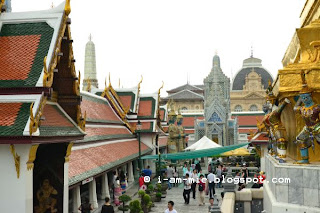The palace complex, like the rest of Ratanakosin Island, is laid very similar to the palaces of Ayutthaya, the glorious former capital of Siam which was raided by the Burmese
The new palace was built on a rectangular piece of land on the very west side of the island, between Wat Pho to the south, Wat Mahathat to the north and with the Chao Phraya river along the west.
The construction of the Grand Palace began on 6 May 1782, at the order of King Buddha Yodfa Chulaloke (Rama I).Having seized the crown from King Taksin of Thonburi, King Rama I was intent on building a capital city for his new Chakri Dynasty. He decided to move the seat of power from the city of Thonburi, on the west side of the Chao Phraya river, to the east side at Bangkok. The new capital city was turned into an artificial island when canals were dug along the east side. The island was given the name 'Rattanakosin'. The previous royal residence was the Derm Palace, constructed for King Taksin in 1768.
Over the succeeding years the king began replacing wooden structures with masonry, rebuilding the walls, forts, gates, throne halls and royal residences. This rebuilding included the royal chapel, which would come to house the Emerald Buddha.
King Rama I ordered his men to go upstream to the old capital city of Ayutthaya, which was destroyed in 1767 during a war between Burma and Siam. They were tasked with the dismantling and removal of as many bricks as they could find, while not removing any from the temples. They began by taking materials from the forts and walls of the city; by the end they had completely levelled the old Royal Palaces.
The Upper Terrace:
- Phra Siratana Chedi - a reliquary in the shape of a golden chedi.
- Phra Mondop- repository of Buddhist sacred scriptures inscribed on palm leaves.
- Miniature Angkor Wat
-Royal Pantheon
- and statues of elephants scattered around the terrace
- Phra Thinang Chakri Maha Prasat -composed of nine major and minor halls, structured in a similar scheme to the Maha Montien Halls from north to south, however the two building groups contrasts greatly in styles.The changing of the guards occurs at the front courtyard every two hours.
- Phra Thinang Boromphiman.-the Boromphiman Throne Hall became the most modern building within the Grand Palace; it was also the first to be designed to accommodate carriages and motorcars.Currently the palace is not open to the public, and serves as the official guest house for visiting Heads of State and their entourage.
 |
| guard at the Throne Hall |
Thai Kings stopped living in the palace around the turn of the twentieth century, but the palace complex is still used to mark all kinds of other ceremonial and auspicious happenings.
A strict dress code applies. The Grand Palace with The Temple of the Emerald Buddha is Thailand's most sacred site. Visitors must be properly dressed before being allowed entry to the temple. Men must wear long pants and shirts with sleeves (no tank tops. If you're wearing sandals or flip-flops you must wear socks (in other words, no bare feet.) Women must be similarly modestly dressed. No see-through clothes, bare shoulders, etc. If you show up at the front gate improperly dressed, there is a booth near the entrance that can provide clothes to cover you up properly (a deposit is required).
The Grand Palace is open every day from 8:30 to 3:30, unless it's being used for a state function, which is quite rare. Be careful of scammers working outside the palace area who tell you its closed, and suggest their own guided tour instead, their 'tour' will be to several shops where they get commissions on your purchases. I was almost a victim to that kind of scam myself right at my hotel, good thing a read it on internet.
Take note also that the admission fee also includes an admission ticket to Vimanmek Mansion valid within seven days of your Grand Palace visit.
Getting to the Grand Palace is easy by boat. Take the Chaophraya Express Boat to the Chang Pier (Tha Chang). Walk through the market around the pier and out onto the plaza flanked by old shophouses. The long white wall of the Grand Palace is across the street on your right. The entrance is the second gate in the wall.

































No comments:
Post a Comment
Please share your thoughts...